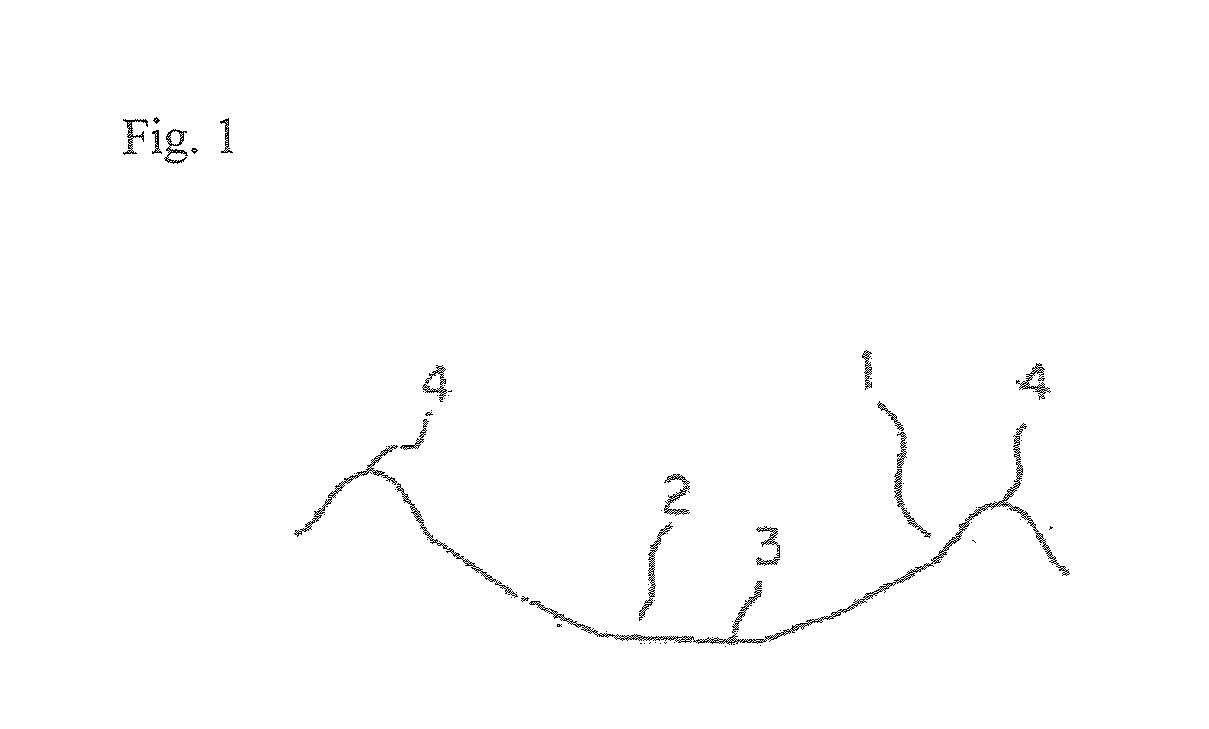Light-reflecting sheet and shaped article thereof
a technology of light-reflecting sheets and shaped articles, which is applied in the direction of instruments, synthetic resin layered products, transportation and packaging, etc., can solve the problems of high cost of process such as bending or other, and insufficient study on thermoformable sheets, etc., to achieve excellent light-reflecting properties and high light-protection. the effect of high light-reflectan
- Summary
- Abstract
- Description
- Claims
- Application Information
AI Technical Summary
Benefits of technology
Problems solved by technology
Method used
Image
Examples
production example 1
[Production of PC Oligomer]
[0127] In 400 L of a 5% by mass sodium hydroxide aqueous solution was dissolved 60 kg of bisphenol A to prepare a sodium hydroxide aqueous solution of bisphenol A.
[0128] Next, the sodium hydroxide aqueous solution of bisphenol A kept at room temperature and methylene chloride were introduced at a flow rate of 1.38 L / hr and 69 L / hr, respectively through an orifice plate into a tube reactor with an inner diameter of 10 nm and a length of 10 m, into which phosgene was concurrently injected at a flow rate of 10.7 kg / hr to continuously react for 3 hrs.
[0129] The tube reactor used herein was double-tube, of which a jacket section was flown with cooling water to keep the temperature of the discharged reaction solution at 25° C. pH of the effluent was adjusted to 10 to 11.
[0130] The reaction solution thus obtained was left to stand to separate and discard the water phase and collect the methylene chloride phase (220 L), yielding a PC oligomer (concentration, 3...
production example 2
[Production of Reactive PDMS]
[0131] 1,483 g of octamethylcyclotetrasiloxane, 96 g of 1,1,3,3-tetramethyldisiloxane, and 35 g of 86% by mass of sulfuric acid were mixed and stirred at room temperature for 17 hrs. The oil phase was then separated, to which 25 g of sodium hydrogen carbonate was added to stir for 1 hr. After filtration, the reaction mixture was vacuum-distilled at 150° C. under 3 Torr (4×102 Pa) to remove low-boiling products to yield an oil.
[0132] 294 g of the oil obtained above was added to a mixture of 60 g of 2-allylphenol and platinum chloride-alcoholate complex in an amount of 0.0014 g in terms of platinum at 90° C. The mixture was stirred for 3 Ms while keeping the temperature at 90 to 115° C.
[0133] The product was extracted with methylene chloride, washed with 80% by mass aqueous methanol three times to remove excess 2-allylphenol. The product was dried with anhydrous sodium sulfate and the solvent was distilled off to a temperature of 115° C. under a reduced...
production example 3
[Production of PC-PDMS Copolymer]
[0135] In 2 L of methylene chloride were dissolved 138 g of the reactive PDMS obtained in Production Example 2, with which 10 L of the PC oligomer obtained in Production Example 1 was further admixed. To this were added a solution dissolving 26 g of sodium hydroxide in 1 L of water and 5.7 cm3 of triethylamine, which was stirred at 500 rpm and reacted at room temperature for 1 hr.
[0136] After completing the reaction, a solution prepared by dissolving 600 g of bisphenol A in 5 L of a 5.2% by mass sodium hydroxide aqueous solution 8 L of methylene chloride, and 96 g of p-ert-butylphenol were added to the above reaction mixture which was stirred at 500 rpm and reacted at room temperature for 2 hrs.
[0137] After the reaction, 5 L of methylene chloride was added to the reaction mixture, which was then water-washed with 5 L of water, alkaline-washed with 5 L of a 0.03 mol / L sodium hydroxide aqueous solution, acid-washed with 5 L of a 0.2 mol / L hydrochlor...
PUM
| Property | Measurement | Unit |
|---|---|---|
| Temperature | aaaaa | aaaaa |
| Temperature | aaaaa | aaaaa |
| Temperature | aaaaa | aaaaa |
Abstract
Description
Claims
Application Information
 Login to View More
Login to View More - R&D
- Intellectual Property
- Life Sciences
- Materials
- Tech Scout
- Unparalleled Data Quality
- Higher Quality Content
- 60% Fewer Hallucinations
Browse by: Latest US Patents, China's latest patents, Technical Efficacy Thesaurus, Application Domain, Technology Topic, Popular Technical Reports.
© 2025 PatSnap. All rights reserved.Legal|Privacy policy|Modern Slavery Act Transparency Statement|Sitemap|About US| Contact US: help@patsnap.com



